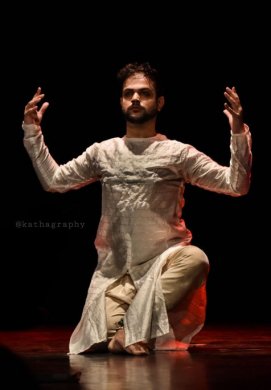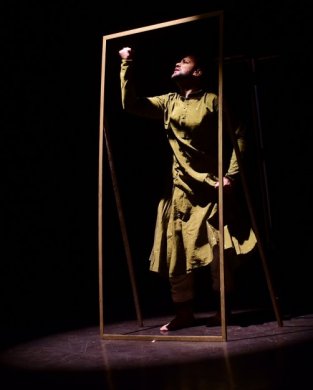
|   |

|   |
 e-mail: leelakaverivenkat@gmail.com Slick Kathak expression of an Unprecedented Awakening Photos courtesy: Sudip Chakraborty June 18, 2022 Watching on video the latest solo presentation of Kathak dancer Sudip Chakraborty, one is made aware of the fact that the blanket fog over dance performances during the pandemic, resulting in a feel of total hopelessness, had its redeeming side too. The forced quietude with the absence of showmanship and performance glamour, made many dancers delve inwards to ponder and meditate on their inner self, always elusive in tactility - questioning one's relationship with the universe and with the art form one represented. Can dance give that sense of wholeness, regenerating the human spirit? Trained under Gurus Pranab Sanyal and Sandip Mallick based in Kolkata, dancer Sudip Chakraborty, given his arresting stage presence and well held erect body, dances with faultless ang, revealing an involvement in every moment - rhythmic or interpretative. In Unprecedented, leaving aside the degree of conviction in the dance statement, one is struck by the fact that a youngster is not afraid to experiment with themes which do not have, in the classical repertoire, readymade prescriptions for presentation. One is also struck by the painstaking attention paid to creating the libretto with musical foundation–not least of it being a team of competent musicians, Jaydeep Sinha (vocal), Aman Ali Khan (tabla), Salman Warsi (pakhawaj), Azeem Ali (sarangi), Salim Viswamitra (sitar), and Seedartha Awakunj Bhattacharjee (bol padhant).  Basing each segment of this theme on the awakening of inner consciousness, on a tala, with the poetic, interpretative segments punctuated with prescribed nritta ensembles pertaining to each time cycle, the rich rhythmic element of Kathak was also given full room to bloom. The starting scene Awakening, in Chautal (set to 12 matras), with the dancer taking up stance after an entry to the mnemonics of takita dha, dhadhakita is with an ode to the Sun God "Om japa kusum sankaasham, Kashyapeya mahadhyutim...." paying homage to this son of Kashyap. The dancer offers salutation to this radiant dispeller of darkness, as beautiful as the flower. But for this giver of all life, there would be no Nature and the first lyric by Pandit Jnan Prakash Ghosh set to raga Bhairav in chautal, takes one to the beauty of Vrindavan, with the blooming flowers, the drone of the bees, the dancing peacock, and the sound of Krishna's flute in a kind of melodious 'suprabhat'. The next part set to teental has the performer with bound eyes portraying self- blinded man, steeped in clichéd ideas pursuing worthless goals and trapped in self-created darkness, taking him away from making the right choices. He, unknowingly, has nursed and got lost in a divisive world immune to the beauty of Nature and what is meant to be Man in Nature, becomes Man and Nature as antagonistic identities, each harming the other.The lyric, composed by Sudip himself is set by Jaydeep Sinha to raga Miya Malhar. "Aiso khel rachi shamko Ke rain din sou janam bitayo Mujh sang khelun main ankh micholi...."  Using the prop of a rectangular frame on stage, the dancer goes in and out of the frame portraying a man engaged in a futile blind man's buff with himself, for who is the enemy and who the victim in his self indulgent world? "Jab lin parda hathake ankh so, Kya khub rang dikhyo." Only when awareness makes him remove this blindfold, does he begin to see the true colours, beauty and meaning of life. The 14 beat force of Dhamar taal, has the dancer portraying in quick flashes the wars, strife, hatred and pestilence like Covid, despite so called scientific discoveries labelled as 'progress'. Set to raag Jog, comes the soothing recitative sounds of the Buddhist Lotus Sutra, the Christian, the Hindu and Islamic chants. Experiencing that sense of wholeness the evolved mind realizes that what one is looking for is within and not outside. And comes the discovery that one is a microcosm of that macrocosm, present in every aspect of dance, of life, of sringar on stage, of the sound of the ankle bells, of the heartbeat. Ending with the chanting of "Poornamada, poornamidam, poornamudachyate, poornasya poornamadaya, poornameva vashishyate" was the perfect note for sloka from the Upanishad, which is on this sense of wholeness, where no matter what or how much you remove, still remains whole.' A fine idea was also to conclude with the Dhrupad syllables and finally Muhammad Allama Iqbal's Kalam. Over time, with experience, Sudip's creative imagination will develop increasing maturity and sharpness.One sees in his work, a definite influence of Aditi Mangaldas in the way he takes recourse to a dance theatre style of soliloquizing or using verbal narration filling up gaps in a story he is tracing.This collaboration of spoken word and danced image always needs to be finely balanced. The fine understanding between music and dance was praiseworthy.  Writing on the dance scene for the last forty years, Leela Venkataraman's incisive comments on performances of all dance forms, participation in dance discussions both in India and abroad, and as a regular contributor to Hindu Friday Review, journals like Sruti and Nartanam, makes her voice respected for its balanced critiquing. She is the author of several books like Indian Classical dance: Tradition in Transition, Classical Dance in India and Indian Classical dance: The Renaissance and Beyond. Post your comments Pl provide your name and email id along with your comment. All appropriate comments posted with name and email id in the blog will also be featured in the site. |